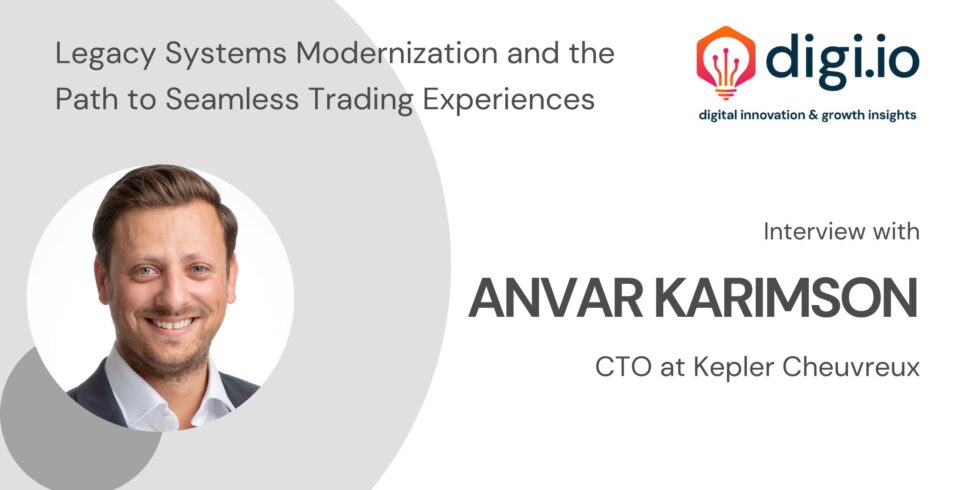Welcome to digi.io – Digital Innovation and Growth Insights – a series of interviews with the brightest minds in finance and technology, where they share insights on digital innovation and growth acceleration. As technology continues to shape and reshape our lives, digi.io’s goal is to delve into the minds of experts who have navigated its complexities, overcome challenges, and harnessed its potential to achieve remarkable success. We’ll explore the emerging trends that will define our future and gain an insider’s perspective on the strategies that drive growth in the financial services world.
The first expert we had the pleasure of interviewing is Anvar Karimson – Chief Technology Officer at Kepler Cheuvreux. Anvar has over 15 years of experience designing and building high-performance trading platforms and execution optimization services. As the CTO of the company, his strategic leadership and technical expertise play a crucial role in ensuring seamless trading experiences, reducing latency, and enabling the firm to handle high-velocity trade throughput.
Kepler Cheuvreux is an award-winning independent European financial services company that specializes in a wide range of areas including Research, Execution (KCx), Fixed Income and Credit, Structured Solutions, Corporate Finance, and Asset Management. With a dedicated team of approximately 600 professionals, the firm has a strong presence in 13 major financial centers across Europe and the United States, including Amsterdam, Brussels, Frankfurt, Geneva, London, Madrid, Milan, New York, Oslo, Paris, Stockholm, Vienna, and Zurich.
KCx, the Execution brand at Kepler Cheuvreux, is focused on being the most trusted, agile, and multi-local agency broker in the industry. Its mission is to build solutions that clients love.
We speak with Anvar below on all things legacy systems modernization and hear his tips on how to achieve a seamless trading experience.
Q. What are the key technology trends that you see shaping the financial services industry now? How is KCx leveraging them to remain competitive?
In the financial services industry, data is undeniably at the core of all significant technology trends we observe today. As storage costs continue to drop, fuelled by advanced big data technologies and flexible cloud pricing, the amount of data accumulated has grown significantly. This ease of data storage has also led to an increase in the volume of noisy and ill-defined datasets. Many of these initiatives, driven by a “build-it-and-they-will-come” mentality, have been powered by the hope that large-scale data processing tools would automatically yield valuable signals amidst the noise.
However, we’re seeing a shift in this narrative, with the pendulum swinging back from big data to clean data. It’s becoming increasingly crucial to have well-defined questions and to work iteratively with the business from the outset, favoring quality over quantity.
Simultaneously, the rise of streaming, event-driven architecture is transforming the industry. This development, observed not just at the component level but across the entire architecture, provides users with a continuous stream of data and insights. As a foundation for building intelligent trading platforms, real-time processing and monitoring significantly reduce response times, allowing for more dynamic client interaction.
Integration and interoperability have also become more vital than ever. The insights of the future will likely be discovered at the intersection of systems and platforms, necessitating the integration of data and functionalities.
Further, the application of intelligence is no longer an add-on but an integral part of the system. Large Language Models, like GPT-4 and Claude, are increasingly embedded into our daily tools. With trading platforms following suit, the clean, real-time streaming data across all systems within a trading estate offers these technologies an unprecedented opportunity to convert data into insights intelligently.
At KCx, our mission is to build solutions clients love, and our data and analytics technologies play a big part in supporting that mission. By having frequent discussions with our clients and investing in understanding their pain points, we are able to leverage our technology and data to bring the right insights at the right time.
At the core of our algorithmic trading platform is an event-driven streaming architecture giving us a dynamic real-time view of everything happening on the platform. The architecture brings together all our components together into a single cohesive stream of data, normalizing across systems and functions, producing clean high-quality datasets. To further expand our capabilities, we have also recently invested in our analytics, partnering with leading data and analytics providers.
Q. In the context of trading, what are some of the main challenges and opportunities you see in the adoption of AI?
As a technologist, the rise of capabilities in AI is hugely exciting. The rate of innovation and exploration that is currently happening in the field is almost unprecedented, especially in the open-source world, where we have seen open models maturing at an amazing speed. While the capabilities are very impressive, the technology does pose some problems in the context of trading, especially around latency, regulatory questions, interpretability, and explainability.
Having said that though, we still see this as a very disruptive technology that can help and support us across all departments, whether operational, client-facing, or technology. We currently have a number of projects evaluating the capabilities across trading, compliance, and data classification.
Q. Legacy systems and applications are holding back many business processes. What are the challenges that they present for trading teams?
Trading teams face significant hurdles with legacy systems and applications, mainly due to several interconnected challenges.
The first issue arises from their notorious lack of interoperability. Legacy systems often struggle to interact seamlessly with other, especially newer, systems. This interoperability issue can obstruct the integration of new technologies or platforms into the existing infrastructure, hampering progress and slowing the adoption of more efficient processes.
Data accessibility is another major concern with these legacy systems. They tend to create data islands, which are isolated pockets of information that are hard to access and leverage. In a fast-paced trading environment where decisions are driven by data, this drawback could be detrimental to operations. Difficulty in extracting valuable insights or implementing automation can diminish the effectiveness and competitiveness of trading teams.
Legacy systems also have a tendency to encapsulate old, and possibly outdated, workflows. Designed around processes that were standard at the time of their implementation, these systems provide limited opportunities for change or adaptation to newer business models or market trends. This inflexibility can put a damper on process improvement and innovation.
One common characteristic of legacy systems is the reliance on tactical fixes. These are short-term solutions addressing immediate problems without targeting the underlying structural issues. While these fixes might offer temporary relief, they could mask significant, structural problems, creating an illusion of functionality while possibly exacerbating the real issues beneath the surface.
Finally, a key drawback of these systems is their lack of agility. As markets become more dynamic and technology continues to evolve at a rapid pace, these systems might not be able to keep up. The inability of trading teams to adapt swiftly to changing conditions due to this lack of agility can undermine their efficiency and competitive edge.
In essence, trading teams are challenged by the inherent issues of legacy systems including lack of interoperability, data isolation, inflexible workflows, reliance on tactical fixes, and lack of agility. These challenges underscore the importance of modernizing systems and processes to stay competitive in today’s rapidly changing business landscape.
Q. Legacy systems modernization is a complex and long process. What are some of the key factors that should be considered before embarking on this journey?
Legacy system modernization is indeed a complex and prolonged process, demanding careful consideration and strategic planning before diving in. The most critical aspect to begin with is understanding the reasons behind the upgrade – the ‘why’ of the initiative. The motivation for modernizing your legacy systems should ideally be tied to addressing a specific business issue or enhancing business capabilities.
Next, it’s important to clearly define what you’re migrating to. In my experience, the most successful large-scale modernization projects either revolve around updating functionalities using a technology that’s already well-understood or maintaining the existing functionalities but transitioning them to a newer, perhaps less familiar, technology. This approach enables the implementation team to concentrate on either learning the new functionalities or the new technology, rather than trying to navigate both simultaneously.
Another crucial factor to consider is how to measure success and determine when the modernization process is complete. Having a tangible objective in mind facilitates tracking of the modernization journey, enabling early identification of potential obstacles or deviations from the intended path.
Lastly, the management of change requests for the legacy system during the modernization process cannot be overlooked. This includes crafting a plan for handling system enhancements, bug fixes, or other changes that arise during the transition, without causing disruptions or delays. Balancing the ongoing maintenance of the legacy system with the progression of the modernization project can be a challenging aspect, but it is paramount for ensuring business continuity.
Q. What are some of the key problems that can occur when modernizing legacy systems?
Modernizing legacy systems is a significant undertaking that can introduce numerous challenges if not adequately planned and executed. There are a couple of key problems that frequently arise in this process, the first of which involves the scope of the project.
Often, the scope can widen unintentionally as new functionalities are added outside of the original delivery plan, without adequately assessing their impact on the overall project. This can lead to increased complexity and potential delays, particularly if these new functionalities significantly differ from the original project specifications.
The second key problem is adopting technologies that may lack sufficient maturity. While it can be enticing to utilize cutting-edge technologies in modernization efforts, they might necessitate the implementation team to spend an inordinate amount of time on setting up non-value-added infrastructure functionalities. This diverts the team’s focus from implementing the crucial business functionalities required for the project.
Finally, an influx of issues or change requests for the legacy system during the modernization process can pose significant difficulties if there isn’t a proper procedure in place to manage them. These can distract the team, create divergence between the systems, and elongate the migration timeline. This not only disrupts the workflow but also incrementally increases the risk associated with the project. Therefore, establishing a robust process to manage changes and issues is critical in ensuring the smooth and successful modernization of legacy systems.
Q. What is your overall advice on achieving a seamless trading experience?
Creating a seamless trading experience involves a careful balance of several elements, focusing primarily on users’ needs, understanding their workflows, and nurturing open communication.
Fundamentally it is important to focus on the things that are constant:
- Performance: Low-latency highly performing platforms
- Interoperability: Platforms that are able to integrate functionally and data-wise with other systems
- Adaptability: The ability to swiftly adapt to changes in an agile manner
- Reliability and Stability: Reliability and stability are crucial for building trust
- Customization: Personalization features and potentially AI can help customize the trading experience, aligning it more closely with users’ and clients’ needs and providing actionable and timely alerts
- Clean, Actionable Data: The need for clean and actionable data is fundamental, as it forms the basis for effective trading decisions.
These fundamental user requirements should be the guiding factors in the architectural design of the platform.
Immersing ourselves in the end-to-end trading experience as technologists is also crucial to gain a deep understanding of our users, their workflows, and pain points, and adopting a shared vocabulary that bridges the gap between technology and trading. This understanding is just as important as building trust with our stakeholders and clients. To achieve this trust, it’s vital to ensure that everyone is on board with the changes, shares the vision, and feels actively involved in the journey.
Finally, open and transparent communication plays a crucial role. In the face of any project, delays and issues are often inevitable. By communicating these challenges openly, we can collaboratively identify workarounds, defuse potential conflict, and foster a culture of shared responsibility. In doing so, we contribute to an overall more seamless trading experience.


